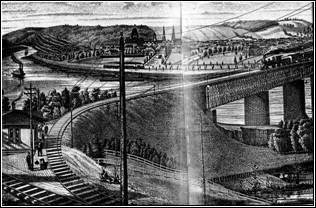Taken from the Western Herald Newspaper
Louden Borland March 19, 1842… respectfully informed the friends and public that he had opened a marbleyard in Steubenville, Ohio where he intended to manufacture marble in all its various branches including mantels, center and table tops, also monuments, head and foot stones which will be done in the best manner of workmanship. They will be neatly engraved in either English or German style. The public was invited to call and examine his stock on Market Street, a few yards above the Means Mill.
May 25, 1845…the same marbleyard was enlarged and Mr. Borland reported “I intend to make Steubenville my place of business in the future and my work will be such as to ensure me patronage.” “ I will deliver stone in set them anywhere in the county at a 20-percent lower price… I can furnish headstones of the best of marble of proportionate size at $5.00 to $20.00.
M. Muldoon … Marble cutting for the Union Marble Works in Steubenville was exhibited in their warehouse showrooms. Among the fine specimens was a monument for the Filson family, finely wrought and resting upon a large massive base of solid marble with a column surmounted with an urn in well portioned. A monument of John Wilson, Short Creek, had a square base with heavy rich molding and a fine column, which was, surmounted a vase and a wreath of flowers. Another is a tombstone for the deceased infant of Mr. Trainer, which was a slab, finished in Gothic style upon which stood the imitation of a seashell. Carved in the center was a miniature pillow of an infant carved of statuary marble of snowy whiteness…designed by Mr. Matthew Gemmell.
Another article appears on July 20, 1859…The Union marble works of Steubenville is becoming justly celebrated throughout the west. Specimens have shown up in New York and Philadelphia and also been seen in Pittsburgh, Cincinnati and Kentucky. The monument for William McCullough of Yellow Creek this county possesses the finish of the smoothness of a mirror, neatly carved 14 feet high upon the face of which is exhibited the face of which bears a shield with the inscription, “Our Father.” Also was noted several tombstones finely carved in a style of an octagon cap with a wreath of oak leaves, Masonic emblems and Bibles as well. Gothic style carvings with leaves, baskets of flowers and hummingbird nestled. Mr. Mouldoon states, “my prices are moderate.”
{C. & P. Railroad Station -bridge across the Ohio River}

Car Shops Located in Steubenville
The Panhandle Route, a short line from New York and Philadelphia to Cincinnati had its car shops located at Steubenville on the Ohio River. The road crossed the river by a magnificent iron bridge, (photo above) of the first railroad bridge created over the stream. When the road was in its infancy the building now used as a paint shop was originally where the locomotive shops and the round house were located. The average force employed over 200 men. The interior of the coaches built was a sight to see. The panel work was veneered with French walnut, which gave it a rich but rather dark appearance. This included baywood moldings, which afforded an effective and beautiful contrast; a very neat leaf shaped turnless molding finished the point of the oval between the windows. Patent heaters were used; a method originated with the master car builder of the Steubenville shops. Much has been said about the uncomfortable seats on many roads but no fault could be found with those made here. They were seventeen and half inches with serpentine backs, considerably higher than the ordinary backs and upholstered in the style of any easy chair. The travelers sit in them as comfortably as if it were his own parlor armchair! The entire cost of these coaches does not exceed $5000. Mr. James McGee was the Master Car builder and came here 10 years ago as a journeyman. Mr. James Copeland was the foreman of the passenger work and Thomas Ferguson of freight work, Edward Elliott of the blacksmith shop and Stewart McBeth, the clerk of the establishment. (Herald Star newspaper, Dec 11, 1872)
Means Foundry and Machine Shop
The Means Foundry and Machine Shop was the oldest works of the kind west of the Allegheny Mountains. It was established in 1816 by Arthur M. Phillips and Robert Carroll and then sold out to James Means and Company who operated it as the Steubenville Foundry and Machine Works.
The plant was incorporated in 1898 and the plant comprised three large brick buildings with a frontage of 360 feet and 500 feet in depth with a machine and pattern shop; foundry and blacksmith building. It was located on the banks of the Ohio River between Dock and North Streets on the C&P railroad spur. It employed over thirty experienced workmen who traded all over the country and Canada. The company was known to manufacture sewer pipes, tile and brick, clay grinding and tampering pans, pug mills, blast furnace, rolling mill glass works, engines and all kinds of iron and brass castings.
In the early 1820’s it employed William McKinley, Sr. the father of the late President William McKinley as a moulder. In 1847 the foundry was owned by W.L Sharpe and for awhile turned its entire attention to the manufacturing of plows and stoves being among the pioneers of this business. For several years George Craig had an interest in the foundry. Mr. Sharp purchased Mr. Craig’s interest and his son, G.E. Sharp became associated with the business under the name of W.L. Sharp and Sons. G.E. Sharp’s son, A.B. Sharp owned it in 1893.